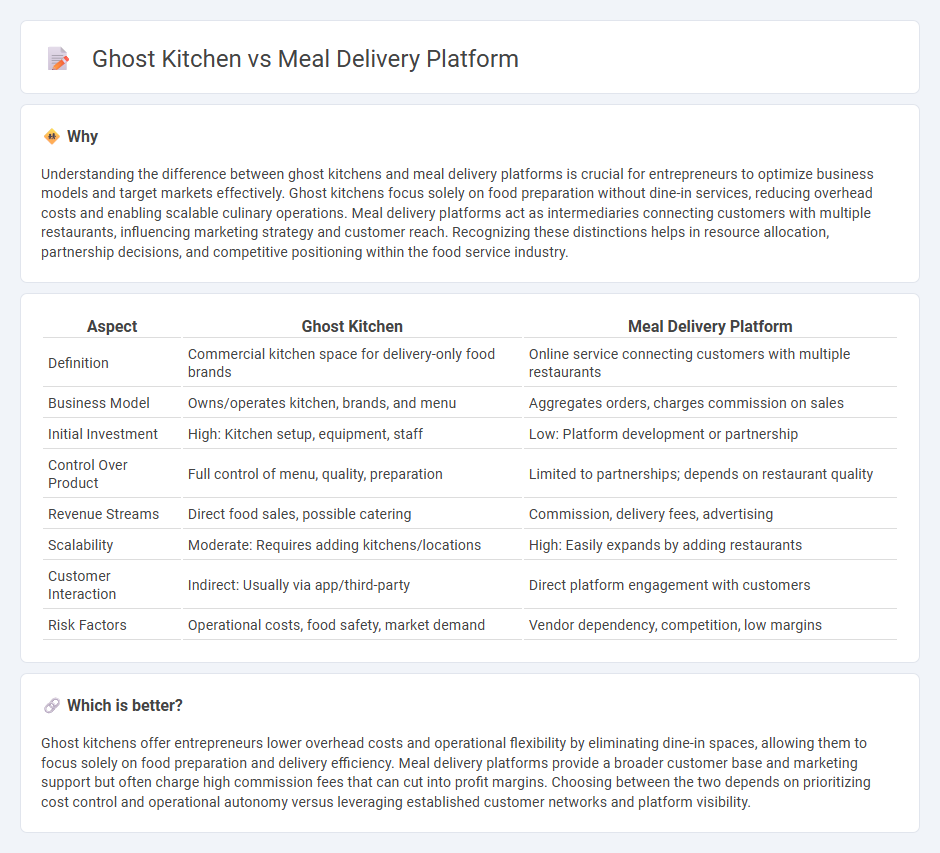
Ghost kitchens operate as delivery-only restaurants without physical dining spaces, reducing overhead costs and increasing operational efficiency. Meal delivery platforms act as intermediaries connecting consumers with multiple restaurants, offering a wide variety of cuisines through user-friendly apps. Explore the unique advantages and challenges of each model to understand their impact on the future of food entrepreneurship.
Why it is important
Understanding the difference between ghost kitchens and meal delivery platforms is crucial for entrepreneurs to optimize business models and target markets effectively. Ghost kitchens focus solely on food preparation without dine-in services, reducing overhead costs and enabling scalable culinary operations. Meal delivery platforms act as intermediaries connecting customers with multiple restaurants, influencing marketing strategy and customer reach. Recognizing these distinctions helps in resource allocation, partnership decisions, and competitive positioning within the food service industry.
Comparison Table
| Aspect | Ghost Kitchen | Meal Delivery Platform |
|---|---|---|
| Definition | Commercial kitchen space for delivery-only food brands | Online service connecting customers with multiple restaurants |
| Business Model | Owns/operates kitchen, brands, and menu | Aggregates orders, charges commission on sales |
| Initial Investment | High: Kitchen setup, equipment, staff | Low: Platform development or partnership |
| Control Over Product | Full control of menu, quality, preparation | Limited to partnerships; depends on restaurant quality |
| Revenue Streams | Direct food sales, possible catering | Commission, delivery fees, advertising |
| Scalability | Moderate: Requires adding kitchens/locations | High: Easily expands by adding restaurants |
| Customer Interaction | Indirect: Usually via app/third-party | Direct platform engagement with customers |
| Risk Factors | Operational costs, food safety, market demand | Vendor dependency, competition, low margins |
Which is better?
Ghost kitchens offer entrepreneurs lower overhead costs and operational flexibility by eliminating dine-in spaces, allowing them to focus solely on food preparation and delivery efficiency. Meal delivery platforms provide a broader customer base and marketing support but often charge high commission fees that can cut into profit margins. Choosing between the two depends on prioritizing cost control and operational autonomy versus leveraging established customer networks and platform visibility.
Connection
Ghost kitchens operate exclusively for meal preparation without a physical dine-in space, serving orders placed through meal delivery platforms. These delivery platforms act as marketplaces, connecting customers with multiple ghost kitchen brands, enabling scalable entrepreneurship in the food industry. The synergy between ghost kitchens and meal delivery platforms reduces overhead costs, accelerates market entry, and drives innovation in culinary offerings.
Key Terms
Business Model
Meal delivery platforms operate as intermediaries connecting consumers with various restaurants, leveraging technology to manage orders and logistics while generating revenue primarily through commissions and delivery fees. Ghost kitchens, also known as virtual or cloud kitchens, are centralized facilities that prepare food exclusively for delivery, reducing overhead by eliminating dine-in services and focusing on efficiency and multiple branded menus under one roof. Explore how these innovative business models are reshaping the food industry and creating new opportunities for entrepreneurs and investors.
Order Fulfillment
Meal delivery platforms centralize order processing, connecting customers with multiple restaurant options and managing logistics for timely delivery. Ghost kitchens optimize order fulfillment by operating exclusively for delivery, streamlining kitchen operations and reducing overhead costs while ensuring faster meal preparation. Explore the operational efficiencies and customer benefits of both models to understand their impact on the food delivery industry.
Customer Acquisition
Meal delivery platforms leverage extensive user bases and marketing algorithms to rapidly acquire customers, benefiting from brand trust and convenient app interfaces. Ghost kitchens focus on operational efficiency and optimized menu offerings but rely heavily on third-party delivery apps for customer access and visibility. Explore how these strategies impact growth and customer retention in the evolving food delivery ecosystem.
Source and External Links
EveryPlate - An affordable meal delivery service offering meal kits starting at $5.99 per serving with easy-to-cook recipes and a variety of weekly changing menus.
Tempo Meals - A flexible, fully prepared meal delivery service that delivers chef-crafted meals ready in two minutes, with options to skip deliveries and select convenient delivery days.
Sunbasket - Provides healthy meal delivery options including heat-and-eat meals and cooking kits featuring organic produce with menus catering to different dietary preferences and lifestyles.
 dowidth.com
dowidth.com